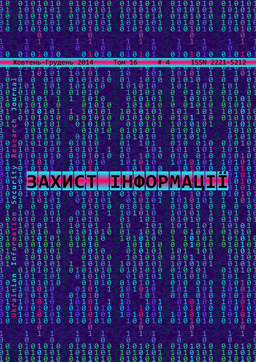Model and methods for protection of structured social group from negative information-psychological impact
DOI:
https://doi.org/10.18372/2410-7840.16.7616Keywords:
information-psychological security, structured social group, hierarchy, activity, managementAbstract
Structured social group (SSG) is highlighted as a particularobject of investigation due to the fact that they are themost vulnerable targets for the realization of negativeinformation-psychological impact. The SSG operates as apowerful amplifier for information-psychological impact,which took place on its senior management. A modeltakes into account the hierarchical structure for SSG’sactivity. In such SSG people are divided into twocategories: coordinators (who can create new informationfor SSG or adequately restore it) and replicator (whichcan pass the information, at best, without distortion). Thisleads to the fact that the quantity of people in each higherhierarchical level is about 6% from the quantity of peoplein the lower level. Methods for SSG protection fromnegative information-psychological impact, which takeinto account their specific features, are developed. Amongthese are: the economic activities of organizations,activities of public institutions, the heterarchy of SSGstructure, the time frame of human functioning as acoordinator in SSG, limiting for democracy etc.References
. Андреєв В. І. Основи інформаційної безпеки / В.І. Андреєв, В. О. Хорошко, В. С. Чередниченко, М. Є. Шелест. – К. : Вид. ДУІКТ, 2009. – 292 с.
. Богуш В. М. Інформаційна безпека держави / В. М. Богуш, О. К. Юдін. – К. : «МК-Прес», 2005. – 432 с.
. Андреєв В. І. Стратегія управління інформаційною безпекою / В. І. Андреєв, В. Д. Козюра, Л. М. Скачек, В. О. Хорошко. – К. : ДУІКТ, 2007. – 277 с.
. Acemoglu D. Economic Origins of Dictatorship and Democracy / D. Acemoglu, J. A. Robinson. – Cambridge: Cambridge University Press, 2006. – 416 p.
. Gehlbach S. Formal Models of Domestic Politics (Analytical Methods for Social Research) / S. Gehlbach. – Cambridge: Cambridge University Press, 2013. – 246 p.
. Шиян А. А., Нікіфорова Л. О. Управління формуванням ефективних економічних інститутів для України / А. А. Шиян, Л. О. Нікіфорова. – Вінниця: ВНТУ, 2011. – 300 с.
. Шиян А.А. Узгоджена система інформаційно-
аналітичного забезпечення держави в Україні як ключовий елемент інформаційної безпеки / А. А. Шиян // Інформаційна безпека. – 2013. – №4(12). – С. 145-151.
. Шиян А. А. Метод моделювання діяльності суб’єктів інформаційної безпеки з використанням операторів, що діють в онтологіях предметних областей / А. А. Шиян // Інформатика та математичні методи в моделюванні. – 2013. – Т.3, №4. – С. 342-352.
. Шиян А. А. Математичне моделювання спільної економічної діяльності людей / А. А. Шиян // Наукові праці ВНТУ. – 2008. – №2. – 7 с. – Доступ до тексту: http://www.nbuv.gov.ua/e-journals/VNTU/2008-2/2008-2.files/ uk/08aasaop _uk.pdf .
. Shiyan A. A. Management Technologies for Higher Level Officers, Presidents, Prime-Ministers and Parliamentarians (September 30, 2011) / A. Shiyan. – Available at SSRN: http://ssrn.com/ abstract= 1936165. – 581 р. Distributed in: Political Institutions: The President & Executives eJournal, Vol. 6, Issue 6, February 09, 2012.
Downloads
Published
Issue
Section
License
Authors who publish with this journal agree to the following terms:- Authors retain copyright and grant the journal right of first publication with the work simultaneously licensed under a Creative Commons Attribution License that allows others to share the work with an acknowledgement of the work's authorship and initial publication in this journal.
- Authors are able to enter into separate, additional contractual arrangements for the non-exclusive distribution of the journal's published version of the work (e.g., post it to an institutional repository or publish it in a book), with an acknowledgement of its initial publication in this journal.
- Authors are permitted and encouraged to post their work online (e.g., in institutional repositories or on their website) prior to and during the submission process, as it can lead to productive exchanges, as well as earlier and greater citation of published work (See The Effect of Open Access).

